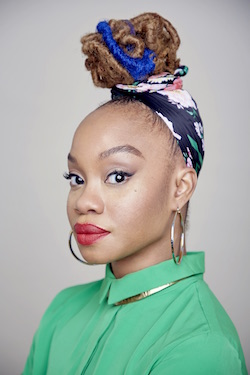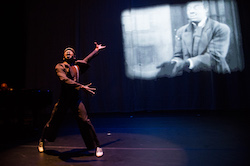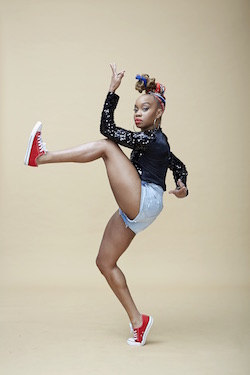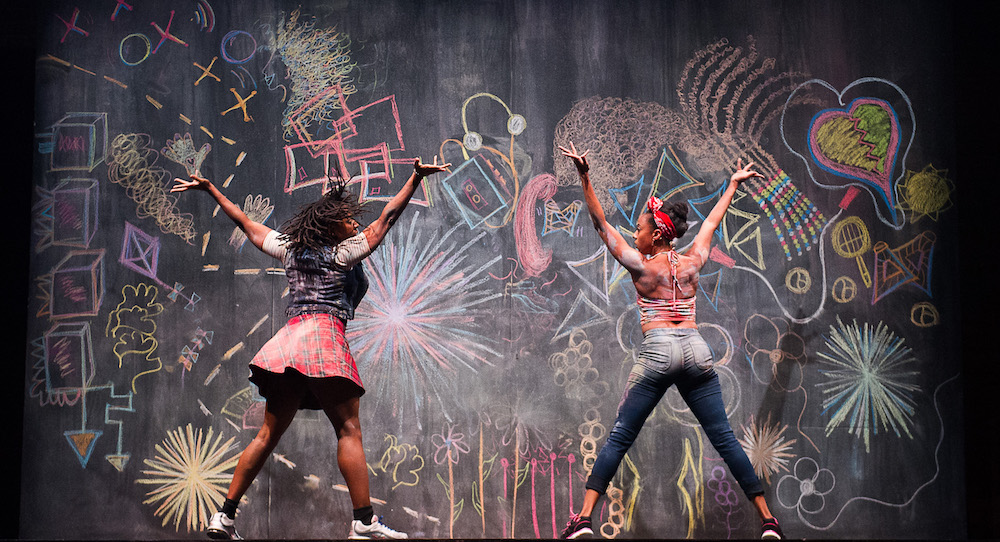Camille A. Brown is a rising dance-world icon. Use of gesture and theatricality, amalgamation of various stylistic influences, and a unique kind of virtuosity makes her work something of which to take true note. As a black woman, who also calls upon African-American cultural heritage and sociopolitical issues in her work, she exemplifies the kinds of artists the field could nurture and exhibit more of with greater efforts at representation and diversity. Brown is reclaiming the cultural narrative of African-American identity, with bold work that taps into both ancestral stories and contemporary culture to capture a range of deeply personal experiences.

Camille A. Brown. Photo by Whitney Browne.
She is a four-time Princess Grace Award winner, a Ford Foundation Art of Change Fellow, Jacob’s Pillow Dance Award winner, Guggenheim Fellowship recipient and TED Fellow. Institutions who’ve commissioned her work include Alvin Ailey American Dance Theater, Broadway theaters and other prominent institutions. She is founder and artistic director of Camille A. Brown and Dancers, through which she creates and presents work aligning with “her driving passion is to empower black bodies to tell their story using their own language(s) through movement and dialogue”. Here, Dance Informa speaks with Brown about her dance-making tools, her work to empower artists and youth with dance, where the dance world stands in regards to diversity and inclusion of various identities, and more.
Much of your work offers powerful commentary on challenging, sensitive sociopolitical issues, yet also brings so much joy. What place do see you for joy in weighty, meaningful contemporary art and societal discourse?
“Joy, pain, sadness, love, hope, faith and exhaustion are all a part of the work. Without joy, we are missing the complete picture of humanity. We have to have joy to keep moving forward.”
Gesture and theatricality are also prominent in your work. What do you feel these elements bring to your work? Why might they be particularly compelling and meaningful to you?

Camille A. Brown & Dancers in ‘Mr. TOL E. RAncE – #4’. Photo by Christopher Duggan.
“Gestural vocabulary is so rich and dense. It’s part of people’s individual way of communicating and is special and rooted in history. All of us have gestural information that lives in our bodies. When I use this language, it is to communicate the accessibility of dance to everyday people. There is also so much meaning in gestural vocabulary, that in some cases can be far more potent than a ‘big’ dance move. The dab, finger snap, head nod, hand on hip and neck roll are all a cultural language, and each one can have several meanings. So, not only am I speaking another language, it’s also a coded, dimensional language. Theatricality takes it all to another level, another realm. It places gestures in a space that moves them past the mundane into an artistic lens.”
Please speak to the same in regards to the stylistic multiplicity in your work, how you bring together elements from many different movement vocabularies to make something uniquely your own (also, wonderfully so, such that the codified vocabulary is far less apparent and seemingly important than the final product of movement)?
“Thank you so much for seeing that! I’m riffing on everything from the hustle, Chicago quick step and lindy hop to tap, African, jazz and hip hop. I am inspired by it all. I always make sure that it’s not an appropriation of these forms but a riff. I call my work a jambalaya!
For me, it’s about listening. The placement of steps comes when I leave myself open to an organic process. For instance, the language of the first section for BLACK GIRL: Linguistic Play is a combination of Juba dance, African-American social dance, double dutch and is also tap-inspired. I wanted to create a black girl’s musical score with the body.”
EVERY BODY MOVE seems to be a meaningful, powerful program in the lives of many youth and artists. How did the program come to be? In the mix of all else you do, what does it mean for you?

Camille A. Brown. Photo by Whitney Browne.
“Everyone has different forms of power. Movement was how I found my identity. I have always had a small voice, and since I was teased as a child, speaking in public became a fear. Dance and movement was a way for me to get past that. I want to let ‘everybody’ and ‘every body’ know that movement is a way to communicate. It’s a form of self-expression and a chance for us to use the body to create our own narratives.”
It seems as if today’s dance world – just like the larger world in which it resides – has made progress on issues of racial justice and representation but has far, far to go. What are salient points evincing both the distance we’ve come, and how far we have yet to travel?
“How women are perceived is still very different from men. If you’re a woman who knows what she wants and is direct, clear and unapologetic, you are (in some instances) seen as ‘difficult’. Men are encouraged to speak their minds and are applauded for their confidence.
There is still an imbalance in terms of the opportunities given to men that are harder for women. The idea of working twice as hard as a black female is still very much alive and present. It is frustrating at times – to know the playing field is not leveled – but to put a positive spin on it, I believe that my experiences make me wiser and stronger. I am growing, and that is what is important.”
By Kathryn Boland of Dance Informa.















